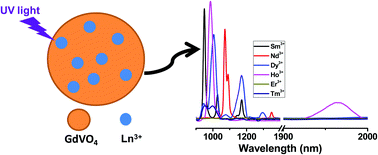Host sensitized intense infrared emissions from Ln3+ doped GdVO4 nanocrystals: ranging from 950 nm to 2000 nm†
Abstract
In this communication we report the observation of intense near infrared (NIR) emissions in the 900 nm to 2000 nm range from colloidal water dispersible lanthanide (Ln3+) doped GdVO4 nanocrystals (Ln = Sm3+, Nd3+, Dy3+, Tm3+, Er3+ and Ho3+). Observing strong NIR emission, particularly from aqueous medium, is a challenge as the luminescence is more prone to non-radiative relaxation. The observed intense NIR emissions from Ln3+-doped GdVO4 nanocrystal ions are attributed to the efficient sensitization of the Ln3+ excited levels via a GdVO4 host matrix. The GdVO4 matrix shows intense and broad absorbance in the ultraviolet (UV) region resulting from the charge transfer from the 2p orbital of oxygen to the d orbital of V5+ ions of the VO4− group. Upon UV excitation, GdVO4 absorbs the light and efficiently transfers the energy to the excited state of the Ln3+ ions, which emit in the NIR region. The calculated energy transfer efficiencies for most of the studied Ln3+ ions are about 90%. In fact, the observed enhancement in the NIR emission intensity varies between 3 (for Sm3+) and 53 fold (Nd3+) compared to direct excitation. The combination of high aqueous stability and intense NIR emission can be advantageous for applications like NIR bioimaging. In addition, these colloidal nanocrystals can easily be incorporated into sol–gel or glass matrices for the fabrication of devices such as optical amplifiers, fiber optics for telecommunications, etc.



 Please wait while we load your content...
Please wait while we load your content...